by Pinchas Cohen
The Week That Was
Globally, equities saw new record highs on earnings growth alongside data, indicating economic growth supports earnings expansion.
The MSCI All-Country World Equity Index posted a record high on Wednesday as well as a record close on Friday.
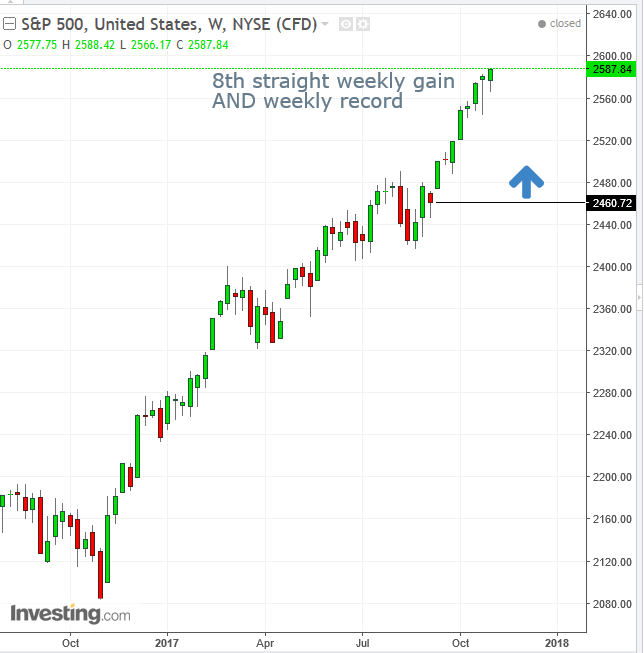
The S&P 500 registered its eighth straight weekly advance, as well as its eighth straight weekly record. The benchmark also posted its 50th record of the year.
US consumer confidence reached a 17-year high this past week, according to the Conference Board’s consumer confidence index. While the Conference Board cites the lowest unemployment since 2001 as a factor in the rating, analysts are attributing the boost in consumer confidence to surging equity markets.
If that’s the case, contrarian investors take note: it would be a bearish signal for equities. The 'participating public,' also known as non-professional investors, tends to join the market at the top. Additional confirmation of this contrarian viewpoint comes from the Investors Intelligence survey which reached a bullish 63.5 percent this week, rising from 63.2 the previous week.
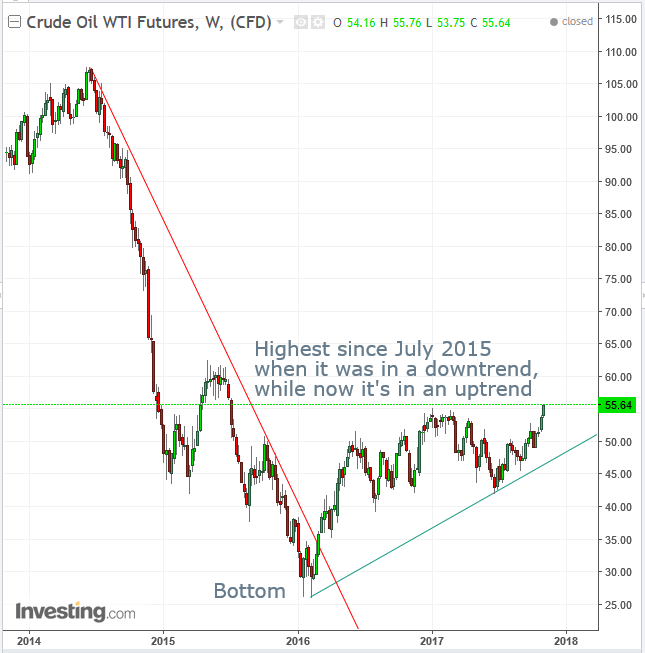
The price of oil reached its highest price since July 6, 2015 on Friday, closing at $55.64, a mere 8 cents from the day’s peak price. Clearly, bulls were comfortable leaving their positions exposed over the weekend.
Not only is the price the highest for the commodity in more than two years, but the last time oil was this high it was actually in a downtrend. This is the highest posted price for crude within an uptrend, rendering this a bull market by any measure.
The acceptable gauge is a 20 percent advance from the lowest point. Since oil bottomed on Friday, February 11, 2016 at $26.05 the price has risen 32.5 percent. Beware though: a bull market does not guarantee that a long position will be profitable. Case in point, between January and June of this year, the price of oil fell more than 20 percent, from $55.24 on January 2nd, to $42.05 on June 19. That didn’t stop the price from rebounding after that, in what turned out to be its biggest rally of the year, which is still ongoing.
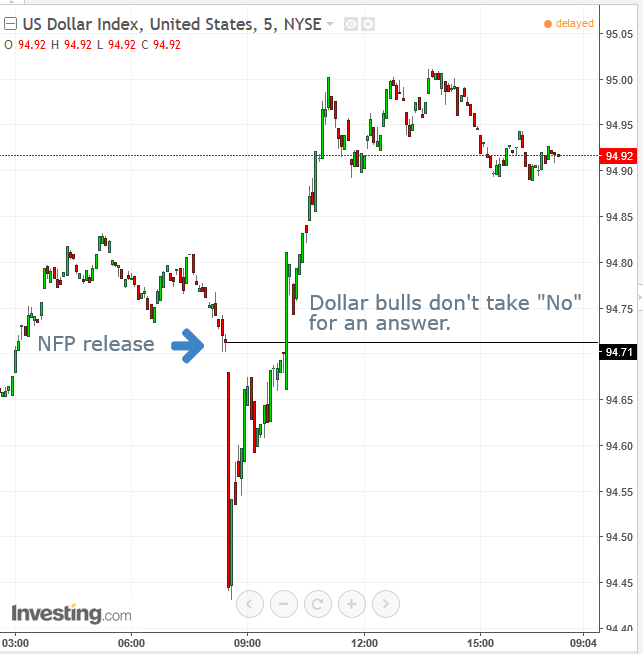
The dollar barely eked out a third straight weekly gain, but it was a gain nonetheless. That despite the NFP release of 261,000 coming in below the 310,000 expectation, and the average hourly wage metric disappointing, remaining flat MoM with a 2.4 percent annualized gain, thereby falling short of the 2.7 percent consensus.
After the NFP results were announced, the Dollar Index immediately fell 0.28 percent, but within 25 minutes the dollar regained much of the loss; after 90-minutes the USD soared past its point of departure before the report was made public. The fact that the dollar decline was short-lived, and that ultimately the currency actually advanced 0.26 percent on a day where the key economic release disappointed, is a testament to the confidence of dollar bulls.
Since the odds of a rate hike in December remain unchanged after this past month's NFP results—other than market activity indicating that investors remain confident it's upcoming despite flat wage growth—the dollar's rise can't be credited to any of these factors. The nomination of Jerome Powell to succeed Janet Yellen as Fed chair can’t be the reason either. For one, it was the consensus expectation. In addition, he’s the most dovish of the short-list names, seen as policy continuity after Janet Yellen.
The only remaining big, FX moving story then is tax reform. Congressional Republicans unveiled their proposal last week which would cut corporate taxes to 20 percent from the current 35 percent. This was the centerpiece of the infamous Trump Trade, which gave the dollar a 5 percent boost during the month following Donald Trump’s election.
In the UK, the BoE raised its interest rate for the first time in more than a decade, from 0.25 percent to 0.50 percent, the result of surging inflation. The move, however, was not supported by rising wages, but rather was due to pound weakness following the Brexit vote, rendering the price of imports higher.
Contrary to reports ahead of the move, UK policy makers signaled further hikes could be in the cards, “at a gradual pace and to a limited extent.” This apparently disappointed pound investors, who sold off sterling, driving it down 1 percent. In place of the currency they picked up UK government bonds, whose current interest rates suddenly seemed relatively more attractive.
The Week Ahead
All times listed are EST
Monday
3:00: Germany – Factory Orders (September): expected to fall 1.6% MoM.
As if political instability driven by populism weren't enough for the faltering euro, what with Germany’s unexpected election results and Spain’s Catalan government declaring independence on one side, to dollar strength on a faster path to higher interest rates in the US and the possibility of tax reform on the other side, this may just be the last straw needed for an outright confirmation of the EURUSD reversal.
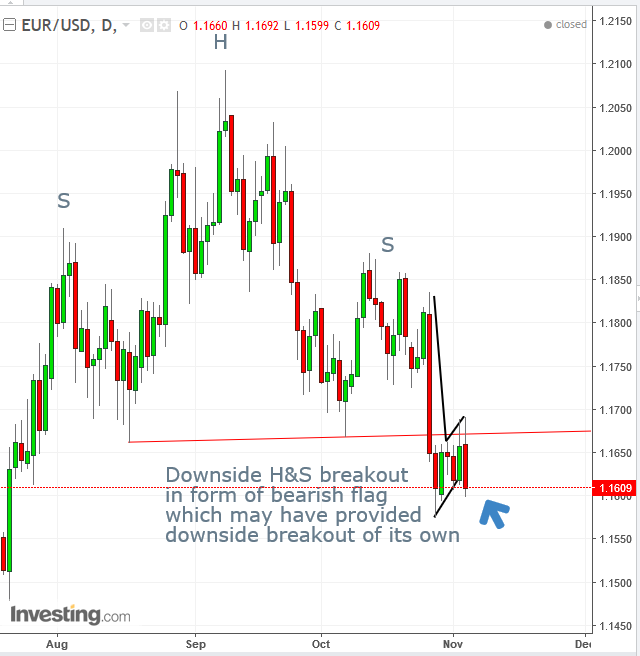
Friday’s dollar advance may have completed a continuation flag pattern for the EURUSD pair, which would suggest a downside breakout, thereby confirming the larger, H&S top reversal.
11:00: Canada – Ivey PMI (October): expected to fall to 58 from 59.6.
23:30: Australia – RBA Rate Decision: no change in policy expected.
Tuesday
6:00: Eurozone – Retail Sales (September): YoY growth forecast to increase to 2.7% from 1.2%.
11:00: US – JOLTs Job Openings (September): growth forecast to fall to 6.080M from 6.082M
23:00: China – Trade Balance (October): exports expected to rise by 8.8% from 8.1% a month earlier.
This release has the potential to strongly impact global markets, from equities, to currencies, commodities and bonds. Global growth relies on China’s growth to sustain its demand on goods from other countries. Recently, Chinese equities have been under pressure, as the government resumed its wave of stricter regulations on leverage in the financial markets, a regulatory initiative which began a year ago. Despite year-long investor concerns about limited profitability from Chinese companies, the overall economy has continued to accelerate, at least so far.
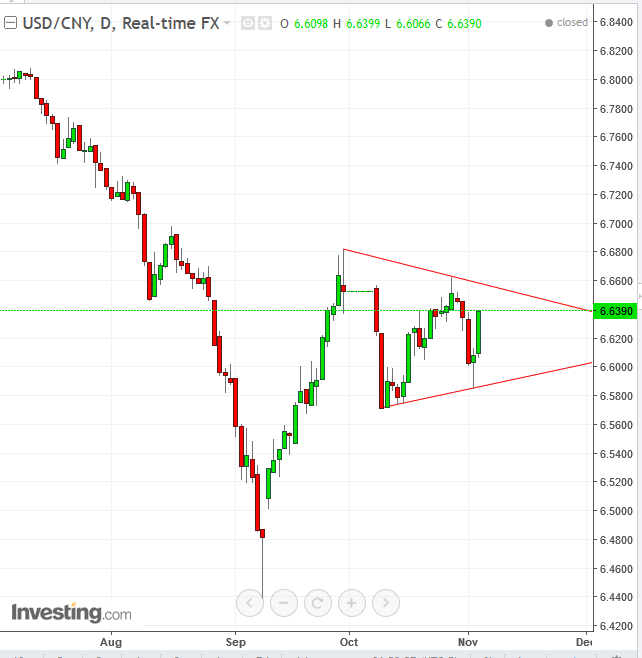
Yuan investors are in a holding pattern, till they decide whether trading the Chinese currency can still be profitable, even with China’s ever stricter crackdown on financial risk. An upside breakout is expected, which would signal a resumption of a bottom.
Wednesday
10:30: US – EIA Crude Oil Inventories (w/e 3 November): the previous week saw a fall of 2.4 million barrels.
21:30: China – CPI (October): expected to rise to 1.8% YoY from 1.6%, and fall to 0.2% from 0.5% MoM.
Thursday
3:00: Germany – Trade Balance (October): surplus expected to rise to €21.5 billion.
9:30: US – Initial Jobless Claims (w/e 4 November): forecast to rise to 236K from 229K.
20:30: Australia – RBA Monetary Policy Statement: this will detail the central bank’s views on the state of the Australian economy.
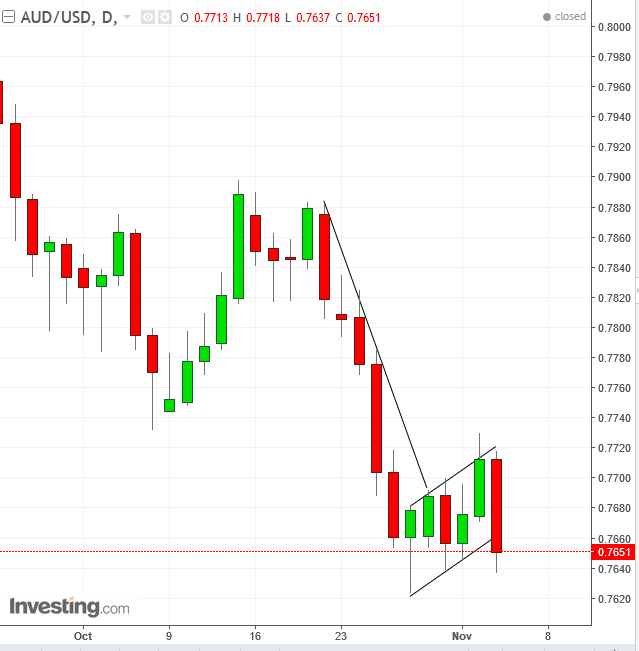
Like the euro-dollar, the AUD/USD pair has been developing a continuation flag pattern, which may have completed with a downside breakout on Friday, signaling a repeat of the preceding sharp move of 3 percent between October 20 and 27.
Friday
5:30: UK – Trade Balance, Industrial Production and Manufacturing Production (September): trade deficit forecast to narrow to £4.7 billion from £5.6 billion.
11:00: US – Michigan Consumer Confidence (November, preliminary): forecast to fall to 97 from 100.7, the highest level in 13 years, since the start of 2004. This would confirm the 17-year high in US consumer confidence, as per the Conference Board's consumer confidence index release last week.
